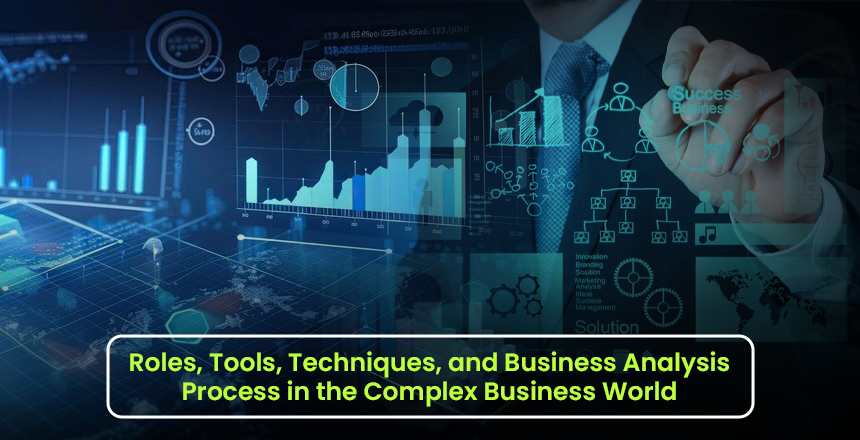That is why, in a constantly evolving world, and specifically the business world, it is critical for all
to do some level of remaining relevant. Every mechanism of conducting business is
complemented by the business analyst. Given these changes, there is a need to learn about the
business analysis role, business analyst tools, the difference between a business analyst and a
data analyst, and the steps needed to execute the job. These aspects will be discussed in this
blog post so that you can know what it takes to become a business analysis and perform well in
this career.
Business Analyst and Their Function
The business analyst occupies a critical position in every organization, and this report will look
at some of the reasons for this. They navigate between the needs of the organization and the IT
solutions developed to meet that need. In a nutshell, a business analyst acquires and evaluates
business needs and determines the best way to meet them while supervising the transition from
need definition to solution implementation. They also interface with IT, operational, and
managerial staff to achieve organizational goals as perfectly as possible.
To be able to fulfill this role, the business analyst is required to have the following soft and
technical skills. Soft skills include good communication, good interpersonal skills, and good
problem-solving skills. Technical competence is about the possession of tools and processes
that enable them to perform their work duties optimally. In the next section, learn how the
business analyst should be comfortable with the following tools most importantly.
Top Business Analyst Tools
The business analyst in this position would be effective in the job if s/he has skills in other tools
that would aid in analysis and working with data and be able to present that data in graphical
form. Some of the top business analyst tools include:
- Microsoft Excel and Google Sheets: These tools are absolutely vital for the generation and
handling of data, as well as necessary to construct interactive graphs and charts. - Business Intelligence (BI) Tools: BI tools are Tableau, Power BI, QlikView, dashboards, and
scores used by business analysts in order to visualize the data dimensions and characteristics. - Collaboration and Project Management Tools: Other applications include Trello, Asana, and
Slack, which enable the business analyst to plan, coordinate the project, and deal with
interbusiness communications. - Requirements Management Tools: Jira, Confluence, and IBM Rational DOORS assist
business analysts to work with requirements and have real-time data to track and document. - Modeling Tools: To some extent, business analysts can use tools such as Enterprise Architect, Lucidchart, and Visio to depict a process or a system at varying degrees of detail in the form of visual models and flowcharts.
A business analyst is completely different from a data analyst.
Business analysts and data analysts are two important personas of the data-driven scenario,
but their roles, respectively, differ. A business analyst specializes in aligning a business with its
goals in terms of reaching the best of its efficiency by modifying its processes and systems.
They focus on the process to map the business needs into the technical structure, the types of
the risks that are present in the project, and the specific inclusion of the stakeholders.
On the other hand, the primary role of a data analyst is to work with data and make meanings
out of it. As a data analyst, it’s essential to interact with data, process it to identify patterns and
trends, or produce reports to inform decision-making. Although there is a difference between the
two positions, both are significant in any organization they are operating in because they have
diverse functions and demand comprehensive skills and knowledge.
This paper explains the business analysis process.
The business analysis process is a set of stages that, in ensuring that the organization achieves
its goals, seeks to confirm that the solution gains the required benefits. The process can be
broken down into the following stages:
- Initiating: The main purpose of this phase is to identify a project’s scope, goals, and potential
limitations by the business analyst. They also define and analyze stakeholders and create an
initial project schedule. - Planning: Based on analysis of the business requirements, the business analyst prepares a
project schedule that contains tasks that need to be completed and the resources and time
needed to complete them. This plan is more used in organizing an Indian project and in
planning and controlling the changes that may occur in the near future. - Eliciting and Analyzing Requirements: In this phase, the business analyst communicates with
the users in order to collect, write down, and assess the business requirements. In addition,
they use methods such as interviews, questionnaires, and seminars to collect information. - Designing Solutions: What the business analyst does next is, once this is ready, sit down with
the team to have an idea of what is the best way to address the requirements that have been
outlined. They draw models, maps, and other tools to describe the solution that is being
implemented. - Developing and Testing: In this phase, the business analyst collaborates with the
development team to actually put up the solution. They make sure that the solution is in
specifications and is fit for its purpose. - Deploying and Maintaining: The implementation of the solution plus support in the longer run
is called the last stage. The business analyst collaborates with the stakeholders with regard to
the assessment of the solution in terms of performance, and changes, if any needed, are made.
Conclusion
Knowledge of the tools used by business analysts is imperative, and so is the set of
competencies that the abovementioned professional should possess. They also need to know
the difference between what they do and what a data analyst does. In this way, adhering to the
business analysis process will help them to guarantee that the organization’s objectives were
met and the solution would provide all the promised benefits. This position will be invaluable as
more organizations fold into imperative decision-information business analysis. By keeping track
of the industry and updating their knowledge, a business analyst is well positioned to remain a
critical cog in the business wheel.








